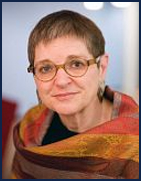The Story of ELUM Professional Development — Be a Resolutionary!

Diane Magrane
Director of Executive Leadership Programs
Part three in a three-part series about the December 2011 Alumnae Program
Framed by a celebration of appreciation and community building, the core leadership learning of the inaugural ELUM professional development program focused on conflict management and negotiation. In the metaphor of a story-teller, we can consider our speaker, Catherine Morrison, JD, to be the master narrator as she guided us through consideration of the context, stakeholders, and personal values inherent in our daily challenges at work and/or home. Her task was to help us apply approaches and techniques to transform perceived differences into proposals with shared value for all parties. She realized that each of us already has achieved a fair amount of expertise in negotiation and conflict management or we would not be in the leadership positions we hold. In this chapter of the Story of ELUM, the story lines were ours to determine — situations, challenges, approaches, and enactment.
We identified common challenges in our 25/10 crowdsourcing and immediately entered together into thinking about leadership challenges, conflicts, and negotiation processes that expand everyone's options in their resolution. We moved from theory and principles to application, from video case studies to our own situations. Catherine expertly blended her own stories (and what an amazing storyteller she is!) with ours. While it is impossible to condense two days of intense learning and problem-solving into 1500 words or less, this column strives to bring to you, the reader, the flavor of our lessons and some pearls of wisdom worth considering for any successful resolution activity.
Conduct a Field Analysis — Prepare Your Game Plan

Catherine Morrison, JD, was the master narrator of part three of the ELUM Professional Development story.
Catherine is an avid basketball fan, but you can envision any field-based sport to prepare for a negotiation. This is an excellent way to remember all the stakeholders in your challenge.
- Who is playing? Who is on your negotiating team and who is on the other side of the field? Who are the parties directly involved in the negotiation or conflict? Who will be at the table?
- Scout the opposition — use your team's research skills to learn about the other team's interests, needs, resources, negotiation style, authority, and strategy.
- Who are the influential people on the sidelines? Assess whether there are influential parties or decision-makers who are observing this transaction from a distance. They are likely to function as coaches or referees. Structure your communications to align with their interests. Use terminology, framing, metaphors, data, or visual messages that will resonate with this highly influential group.
- Who is in the stands? Consider interested observers, fans, scouts, other competitors, senior or middle managers, board members. Their enthusiasm or lack of interest has the potential to influence your outcome. How can you engage or manage their interest?
- Consider the larger context of environment, institutional priorities and financial, political, regulatory, and cultural issues. This is where macro analysis comes into play. Save this analysis for those negotiations or conflicts that are subject to one or more of these larger influences or have the potential to establish or rely upon precedent.
- Plan the next steps.
- Fill the stadium and build your fan base. Who needs to be directly involved? Which influencers can be helpful to you if called in from the sidelines? Who are your fans and supporters? Who has the potential to become one?
- Build and manage coalitions.
Note that this is all about preparation and not active bargaining. The bargaining itself begins with an exploration of ZOPA (Zone of Possible Agreement) and a simultaneous exploration of how your interests and negotiation style match with the other party.
What's Your Style?
Each of us engages in a preferred style of bargaining, which tends to change under circumstances of calm low pressure and stormy high pressure challenges. Our registration confirmation to the alumnae meeting came with a password to access the online Kraybill Conflict Style Inventory, and many of us took the opportunity to discern our preferred conflict management styles. The results are displayed in the table below.
Definitions and Group Composite of Scores of ELUM Participants
(54 completed the survey; numbers shown combine the highest and next highest scores for each category)
Style
|
Respondents Scoring High in Calm
|
Respondents Scoring High in Storm
|
|
Cooperating
|
51
|
46
|
|
Directing
|
17
|
25
|
| Compromising |
47
|
39
|
|
Avoiding
|
8
|
14
|
| Harmonizing |
23
|
15
|
Be careful not to over-interpret this chart since the sample is small and unique: ELAM alumnae who chose to attend a professional development program two weeks before the holidays and accessed their homework prior to arrival. Catherine suggested that the most interesting aspect of this profile is the minimal change in cooperative style in storm, perhaps a result of ELAM selection and training. She encouraged us to broaden our styles and especially to consider the benefits of using avoiding styles when the issues are not urgent and/or the solution not key to moving forward. (My mother would say, "let sleeping dogs lie" and "you catch more flies with honey than vinegar." I guess I should have listened more closely earlier on in my life, because I share the group's tendency to remain in collaborative mode rather than engaging in those avoiding and harmonizing styles.)
Resolutionary Pearls of Wisdom
- Authenticity is persuasive
- Have your feelings or they will have you
- Bring curiosity to the (bargaining) table
- If you've seen one negotiator (male, female, high/mid/low authority), you've seen one negotiator
- Develop a range of styles and select for the situation (think gear shift)
- Assess cultural context, high or low
- B-R-E-A-T-H-E
- Acknowledgment = WD40
- The grass is always greener over the septic tank (Erma Bombeck)
- Memorialize your agreements
- Be a resolutionary!
One of the more vivid moments in our lesson was Catherine's image of calling to mind the women who have gone before us to expand our opportunities, the women who will follow and are watching how we manage our lives, and our colleagues who stand beside us as we walk to any negotiating table. She would add to that a soundtrack of Helen Reddy singing, I Am Woman, Aretha Franklin belting out R-E-S-P-E-C-T, and Lady Gaga flaunting to Born This Way. The next time you have a difficult negotiation, try conjuring up these images. Envision your ELAM colleagues with you, and feel the strength of your heritage. Catherine closed with the charge to all of us to "Be Resolutionaries!"
We rose to our feet in appreciation and remained standing as ELUM Leslie Morrison (ELAM '09), on behalf of the participants and the Alumnae Program Planning Committee, expressed our gratitude to Catherine:
I met Catherine Morrison at the AAMC Leadership Forum about 15 months ago. After the meeting, I wasn't able determine exactly why it had been such a powerful session. Was it something about her background as a social worker, her living in my old stomping grounds of Baltimore, or our shared surname of Morrison? It was none of those things. It was her sheer will to constantly practice and her drive to improve her already astounding skills in conflict management and negotiation. During the past three days, we have learned how to breathe and the power of silence (holding out for up to 15 seconds for a response in negotiation). We learned about the AND stance, and to create solutions that are do-able and durable. We learned the importance of conflict as the creation of energy and light, and the value of cognitive conflict. We learned to reflect, to invite, and to listen for the "third story."
Finally, we learned how to find the hidden rooster in every story, the difference between private, theater, and opera negotiations, and how when we negotiate we are negotiating on behalf of others. These others are the women who stand beside and behind us from the past decades when there was no one helping to negotiate. These are the women standing before us for whom we will pave the way. And, as we negotiate for these others, we hear the resounding refrains of Aretha Franklin, Helen Reddy, and Lady Gaga as we march forward together. Thank you so much, Catherine, for these lessons.
Recommended References
Articles:
"The Necessary Art of Persuasion"
J.A. Conger
Harvard Business Review, pp. 84-95 (May-June 1998)
"How Management Teams Can Have a Good Fight"
K. Eisenhardt, L. Kahwajy, and L.J. Bourgeois
Harvard Business Review, pp. 77-85. (July-August 1997)
"Breakthrough Bargaining"
D. Kolb and J. Williams
Harvard Business Review, pp. 88-97 (February 2001)
"Bargaining Strategies: Collaborative vs. Competitive Approaches"
J.P. Ware
Harvard Business School Publishing, Case Note 9480055, pp. 1-14 (April 1, 1980)
"Diagnosing and Overcoming Barriers to Agreement"
M.D. Watkins
Harvard Business School Publishing, Case Note 9800333, pp. 1-20 (May 8, 2000)
"Negotiation Analysis: An Introduction"
M.A. Wheeler
Harvard Business School Publishing, Case Note 801156, pp. 1-14 (August 29, 2000)
Books:
"Women Don't Ask: The High Cost of Avoiding Negotiation – and Positive Strategies for Change"
L. Babcock and S. Laschever
New York: Bantam Dell, paperback edition (2007)
"Everyday Negotiation: Navigating the Hidden Agendas in Bargaining"
D. Kolb, J. Williams
San Francisco: Jossey-Bass (2003)
"Negotiating at an Uneven Table: A Practical Approach to Working with Difference and Diversity"
P.B. Kritek
San Francisco: Jossey-Bass (1994)
"Difficult Conversations: How to Discuss What Matters Most"
D. Stone, B. Patton, and S. Heen
Second edition, New York: Penguin Books (2010)
Back to Top
ELAM is a core program of the Institute for Women's Health and Leadership at Drexel University College of Medicine, Philadelphia, Pa. The Institute continues the legacy of advancing women in medicine that began in 1850 with the founding of the Female Medical College of Pennsylvania, the nation's first women's medical school and a predecessor of today's Drexel University College of Medicine.